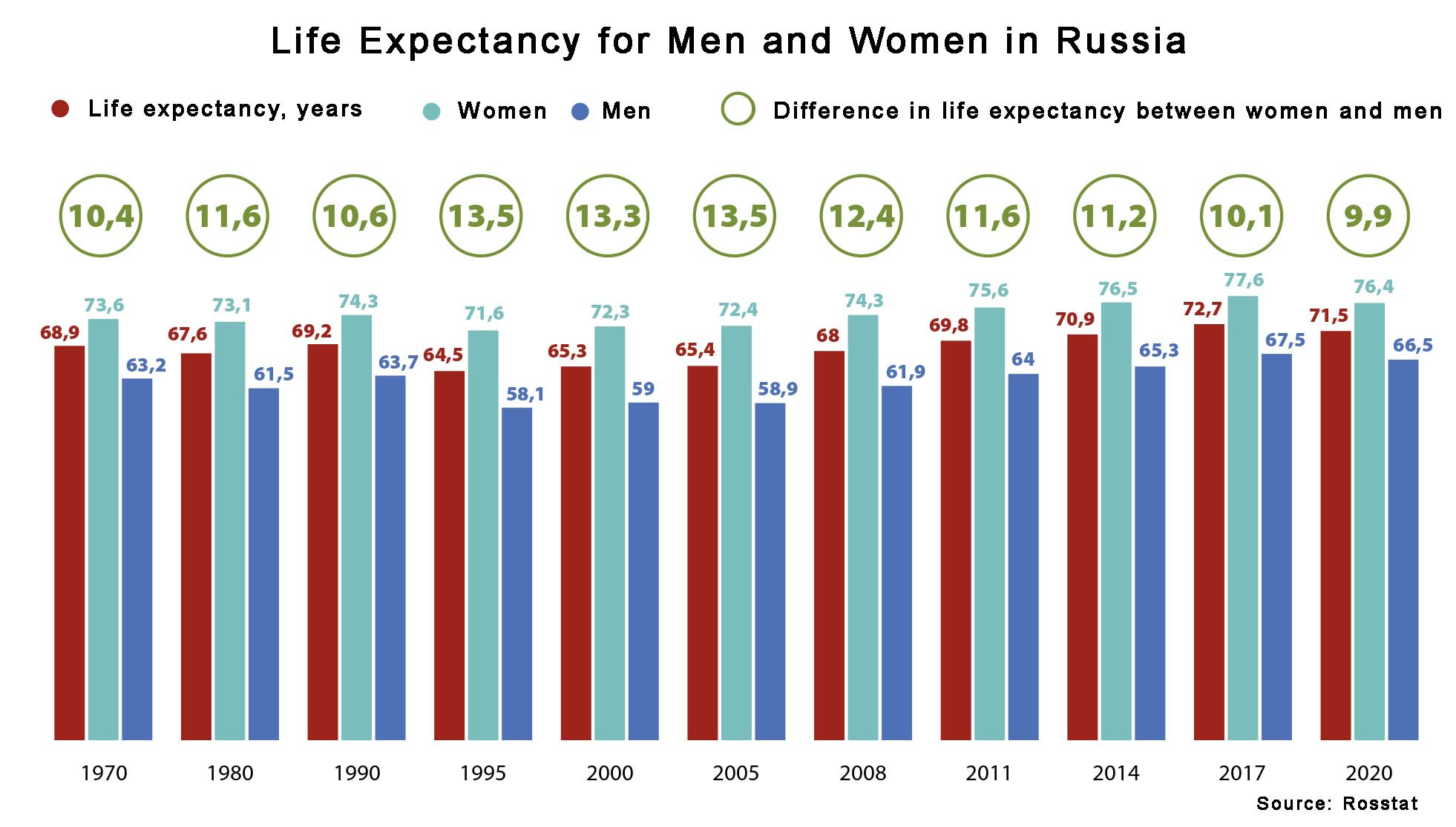Think Before You Drink: Why Women Live Longer Than Men

Women are more likely to live to old age because they are less prone to indulge in bad habits than men. A whole range of social, biological and other factors—such as women being more likely to visit the doctor and exercise—also play an important role. Experts from HSE University and RANEPA analyzed the effects of various factors on the reduction in men's life expectancy, which varies based on habits and ideas about male behavior in different countries.
Genetics and Values
Women have longer life expectancies almost everywhere the world, regardless of the level of economic development, the quality of healthcare, or established gender relations—but the difference is smaller in countries with low mortality rates. Andrey Korotayev, Head of the Laboratory for Monitoring the Risks of Socio-Political Destabilization, and Julia Zinkina, Senior Researcher at the RANEPA International Laboratory for Demography and Human Capital, examined various causes of this phenomenon in the article ‘The Gap in Life Expectancy Between Men and Women: A Review of Genetic, Social and Value Factors,’ published in the HSE journal Demographic Review.

Research on the populations of 44 European countries between 1955 and 2009 made it possible to assess the impact of various factors on the gender gap in life expectancy. The difference ranged from 1.7 years in Macedonia in the late 1950s to 13 years in Russia in the early 2000s. In general, the impact of biological factors is estimated to range from 0.5 to 1.6 years, and the gender gap in life expectancy is partly explained by higher infant mortality in boys. Higher estrogen levels protect women from cardiovascular diseases before menopause. In turn, increased testosterone levels in men frequently produce a tendency towards aggression, risky behavior and ignoring health risks.
The high prevalence of the mitochondrial genome in women reduces the risks of cancer, cardiovascular and neurodegenerative diseases, while hormonal influences increase women’s immune function and improve their ability to cope with multiple stressors at once. ‘The combination of these factors may be a component of women’s longer life expectancy,’ the authors note.
Genetic and biological advantages are only some of the factors that produce a longer life expectancy in women.
Today—especially in developed countries—regular visits to the doctor have become crucial in the prevention and treatment of many deadly diseases
Women visit the doctor more regularly than men, so they are 20% more likely to detect hypertension in time and 1.5 times more likely to keep it under control. Women are also more likely to limit their salt intake and to take more active measures to lose weight, exercise, and take vitamins. At the same time, men’s diets are likely to contain fewer fruits and vegetables and more cholesterol, which increases the risks of heart disease, stroke, diabetes and cancer.
The Dangers of Smoking and Alcohol
Bad habits remain the most significant contributing factor. The above-mentioned study of the population of European countries showed that widespread smoking among men in Russia led to a five-year reduction in life expectancy compared to women between 1990 and 1994. The situation in recent years has remained the same, and the healthy life expectancy of men has fallen by 2.5–3 years compared to women.
Another European study conducted in 31 countries showed that in 2014, the difference in life expectancy at birth was on average 7 years, ranging from 3 years in Iceland to 11.2 years in Russia. Smoking-related mortality accounted for 3 years—43.5% of the gender difference in life expectancy at birth. The absolute contribution of smoking to the mortality rate was highest in Russia (5.3 years), and lowest in Sweden (zero) and Iceland (0.1 years). The gender difference in life expectancy at birth and the contribution of smoking to mortality varied significantly depending on the year of the study, reaching a peak of 9 and 5.2 years respectively in 1995, after which they gradually started to decline.
Studies confirm that men drink more alcohol than women, drink more often, and choose stronger drinks
This largely occurs due to traditional behavioral practices and the associations between drinking, adulthood and the start of independent work.
For example, socialization in working-class communities is often linked to the development of male identity—which has strong ties to alcohol. Young men were encouraged to drink alcohol as a rite of passage into adulthood and a means of distancing themselves from children and female influence. The inability or unwillingness to participate in such activities led to social alienation and mockery. Such ‘traditional’ male behavior is especially common in low-income families with low levels of education.
While analyzing the problem, the authors also studied work on the role of alcohol in life expectancy gender gaps in Estonia, Lithuania, Latvia, Moldova, Poland, Romania, Russia and Ukraine between 1965 and 2012. The study, conducted by Russian sociologists Tatiana Kossova, Elena Kossova and Maria Sheluncova, showed that the gap in life expectancy in these countries increased from 7.3 to 10 years. Alcohol-related mortality caused an average life expectancy gender gap of 1.9 years between 1990 and 2012. The authors assert that in Russian regions, it is impossible to reduce the gap in life expectancy between men and women without reducing the volume of alcohol consumption. This factor and the specific notion of masculinity generated by it (demonstrative disregard for threats to life and health—drunk driving, riding motorcycles and bicycles without protective equipment, aggression, criminal behavior) also lead to a lower life expectancy in men.
In recent decades, there has been a huge increase in the range of research papers on the gender gap in life expectancy, and numerous scientific and interdisciplinary interpretations of its causes. Nevertheless, this phenomenon and its scale cannot be fully explained by either a biomedical interpretation of the data or socio-economic factors. The authors note that the nature of the gender gap in life expectancy is explained by a range of diverse causes that require additional research by biologists, geneticists, sociologists, and psychologists.
See also:
'Motivation for Pursuing Big Goals in Life': What is Taught in 'Population and Development' Master's Programme
In 2023, the Master's Programme 'Population and Development' was ranked among the top educational programmes at HSE University. The HSE News Service explains what makes this programme special, and why specialists in population issues should study Python, housing policy, and public administration.
Elderly People, Crisis, and Robots
Across the globe, countries are witnessing dramatic shifts in the relative proportions of younger and older generations in their demographic makeup. Even in African states, signs of an emerging demographic decline are becoming evident. By 2050, two thirds of people aged 65 and over will be living in low- and middle-income countries. While an ageing population poses a significant challenge to national economies, it can also serve as an impetus for development, especially in the realm of technology. What is the extent of global population ageing, what challenges arise in this context, and whether humanity is capable of addressing them are some of the key questions, explored by IQ.HSE, based on a paper published in Sociological Journal by Leonid Grinin, Anton Grinin, and Andrey Korotayev at the HSE Centre for Stability and Risk Analysis.
Search Query: How to Study Migration with Google Trends
Experts have calculated that the number of international students in Russia has grown six times over the last decade, and researchers say that many of those who are studying today would like to stay in the country. This, alongside issues such as why Google Trends are worth looking into, were covered at the HSE XXIV Yasin International Academic Conference on Economic and Social Development section on demography and labour markets.
Long-awaited Long-term Care
The number of older persons and their life expectancy are on the rise in many countries worldwide. As they age, some people need assistance with daily living activities, something their family is not always capable of providing. This creates a demand for professional long-term care that integrates medical and social services. How Russia can benefit from other countries' experience of providing public long-term care is discussed in a report* presented by the HSE Centre for Social Policy Studies at the XXIII Yasin International Academic Conference on Economic and Social Development hosted by the HSE University.
Where the Babies are Booming: Which Russian Regions Have the Highest Birthrates?
The birthrate across Russia is not uniform: in some areas, people have children earlier in life, and in some, later. These contrasts reflect various populations’ differing demographic outlooks and the dynamics of their respective regions, as well as the extent to which their residents adhere to traditional norms of reproductive behaviour. On the whole, almost no large areas with high birthrates remain in Russia. Here, IQ.HSE studies current trends based on an article by demographer Artur Petrosyan.
Deadly Habits: Why Women Live Longer Than Men
In developing countries, the gap in life expectancies between men and women has been shrinking for a long time—but it has not disappeared completely. In many cases, gender-related differences in mortality in the 45–69 age group account for almost half of this gap. However, in Eastern Europe, early mortality in men aged 50 and under accounts for over a third of it. Demographer Marina Vergeles examined the situation in more than 40 countries and shared her conclusions with IQ.HSE.
Demography and Social Policy: First Readings in Memory of A.G. Vishnevsky Held at HSE University
The Human Capital Multidisciplinary Research Center, together with the Vishnevsky Institute of Demography and the International Laboratory for Population and Health, organized the first demographic readings in memory of HSE University Professor Anatoly Vishnevsky, the first director of the Institute. The experts in attendance discussed a wide range of topics, including family policy, how to improve the conditions of low-income people, and how to correct market and employment setbacks.
Shrinking Vorkuta: Depopulation and Decline of Russian Arctic Cities
In Soviet times, relocation to northern monocities was seen as an attractive option, with high pay and good perks, along with a well-developed infrastructure, perceived as offsetting the harsh climate. The situation is different today, with some cities on the verge of vanishing into extinction. A prominent and rather striking example of this process is Vorkuta in the Komi Republic. A team of researchers from the HSE and Politecnico di Milano, having examined the progressive shrinkage of this once booming monocity, concluded that the case of Vorkuta could suggest effective approaches to managing urban depopulation in the Russian Arctic.
Planning for Babies: How Many Children Russian Families Would Like to Have
Over the past quarter-century, the socially accepted reproductive norm has hardly changed in Russia: most people still believe that two children per family is the ideal. The reality, however, is more diverse, and both largeand childfree families are increasingly commonplace. A new study by HSE demographers looks at changes in public opinion in Russia between 1995 and 2019 concerning the optimal number of children in the family.
Children of Perestroika Turned out to Be Tougher than Children of the Sixties
Due to the COVID-19 pandemic, people around the world have faced an unprecedented crisis. The cataclysm has impacted Russia as well. Who will better deal the hardships—experienced baby boomers, Gen Xers who survived the 1990s, or Gen Yers who have had an easy life?


